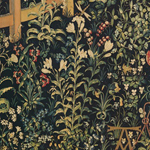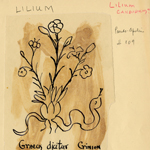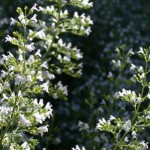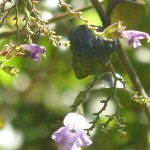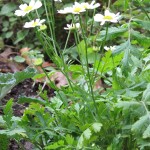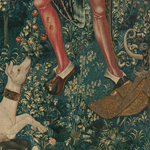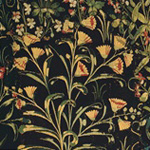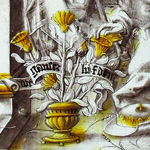Archive for November, 2010
Monday, November 22, 2010
Above from left to right: Margaret Freeman in her office at The Cloisters in 1938; a large and lovely rendering of Lilium candidum prominently placed in the flowery field below the enclosure of the Unicorn in Captivity; tracing of a woodcut image illustrating the entry for the same species of lily, taken by Freeman from the herbal of Apuleius Platonicus, sometimes known as the Pseudo-Apuleius. The Latin subscription states that this lily was known to the Greeks as “Crinion.”
This is not the lily which today is and tomorrow is cast into the oven; it will blossom for ever.
???Saint Bernard of Clairvaux, Sermon 70 on the Song of Songs, III.6
Margaret B. Freeman was associated with The Metropolitan Museum of Art for fifty-two years, first as a lecturer at the old Cloisters in 1928, then as a curator, and eventually as director of The Cloisters in 1955, succeeding James Rorimer. Charged with the development of the gardens, Ms. Freeman was perhaps the single most important contributor to the list of medieval plants drawn from historical sources, which is still in use here. Read more »
Tags: Crinion, James Rorimer, Lilium candidum, lily, Margaret Freeman, Pseudo-Apuleius
Posted in Gardening at The Cloisters | Comments (4)
Wednesday, November 17, 2010
The pretty, fragrant lesser calamint flourishes in all three of the enclosed gardens at The Cloisters. Each small shrub bears a host of delicate little flowers from late summer through frost. Above, from left to right: The lipped flowers of calamint are characteristic of members of the Labiatae, or mint, family; cold weather brings out the purplish cast in the flowers; calamint is beautiful even in winter, when the fine stems are bare.
The larger-flowered calamint, known as Calamintha grandiflora, is frequently grown in modern gardens, but the lesser calamint, Calamintha nepeta, is the calamint of the Middle Ages. Read more »
Tags: calamint, Calamintha grandiflora, Calamintha nepeta, Calamintha officinalis, Cuxa Garden, marjoram, nepitella, Satureja hortensis, Satureja montana, savory, White Cloud
Posted in Food and Beverage Plants, Gardening at The Cloisters, Medicinal Plants | Comments (1)
Friday, November 12, 2010
The common name of feverfew is derived from the Latin febrifuge. Botanists now place this member of the aster family in the genus Tanacetum, but feverfew was formerly known both as Chrysanthemum parthenium and Pyrethrum parthenium and may be listed as such in older sources. Above, left and center: Feverfew??growing in Bonnefont garden in November; right: the only feverfew plant depicted in the Unicorn Tapestries appears between the feet of the hunter poised to spear the quarry in The Unicorn Defends Itself.
Feverfew (Tanacetum parthenium) is a strongly aromatic herb in the aster family; it is closely related to costmary (Tanacetum balsamita) and to tansy (Tanacetum officinale), both of which also grow in Bonnefont garden. While tansy has been employed as a medicine, a food, and an insect repellent, feverfew is strictly a medicinal herb. The medieval name of this antipyretic??species is derived from the Latin febrifuge and refers to its usefulness in driving off fever. Read more »
Tags: antipyretic, balsamita, Capitulare de Villis, Centaurium erythraea, centaury, Chrysanthemum, costmary, febrifuge, febrifugiam, feverfew, herb, Herbarius Latinus, Hortulus, Pyrethrum, Tanacetum, Tanacetum officinale, tansy, Unicorn tapestries, Walahfrid Strabo
Posted in Gardening at The Cloisters, Medicinal Plants, Plants in Medieval Art | Comments (0)
Friday, November 5, 2010
The golden flowers of the calendula, said to bloom in every month of the year, figure in the art, literature, and medicine of the Middle Ages. Called “golds” in medieval English, the flowers were associated with the Virgin and came to be known as “marigolds” by the sixteenth century. Above, from left to right: Detail of a large calendula plant, bearing many blooms, which appears below the golden fence enclosing The Unicorn in Captivity; a calendula blooming in December; the daisy-like flower is often shown in profile in medieval depictions, as in this detail of an urn with three calendula flowers shown in the foreground of a silver-stain roundel depicting the Adoration of the Magi.
‘Golde [Marigold] is bitter in savour
Fayr and zelw [yellow] is his flowur
Ye golde flour is good to sene
It makyth ye syth bryth and clene
Wyscely to lokyn on his flowres
Drawyth owt of ye heed wikked hirores
[humours]. . . .
Loke wyscely on golde erly at morwe [morning]
Yat day fro feures it schall ye borwe:
Ye odour of ye golde is good to smelle.’
???From the herbal of Macer, as quoted in A Modern Herbal
Read more »
Tags: Adoration of the Magi, calendula, Crocus sativus, Konrad von W??rzburg, Macer, marigold, pottage, saffron, Unicorn in Captivity
Posted in Gardening at The Cloisters, Medicinal Plants, Plants in Medieval Art | Comments (0)

